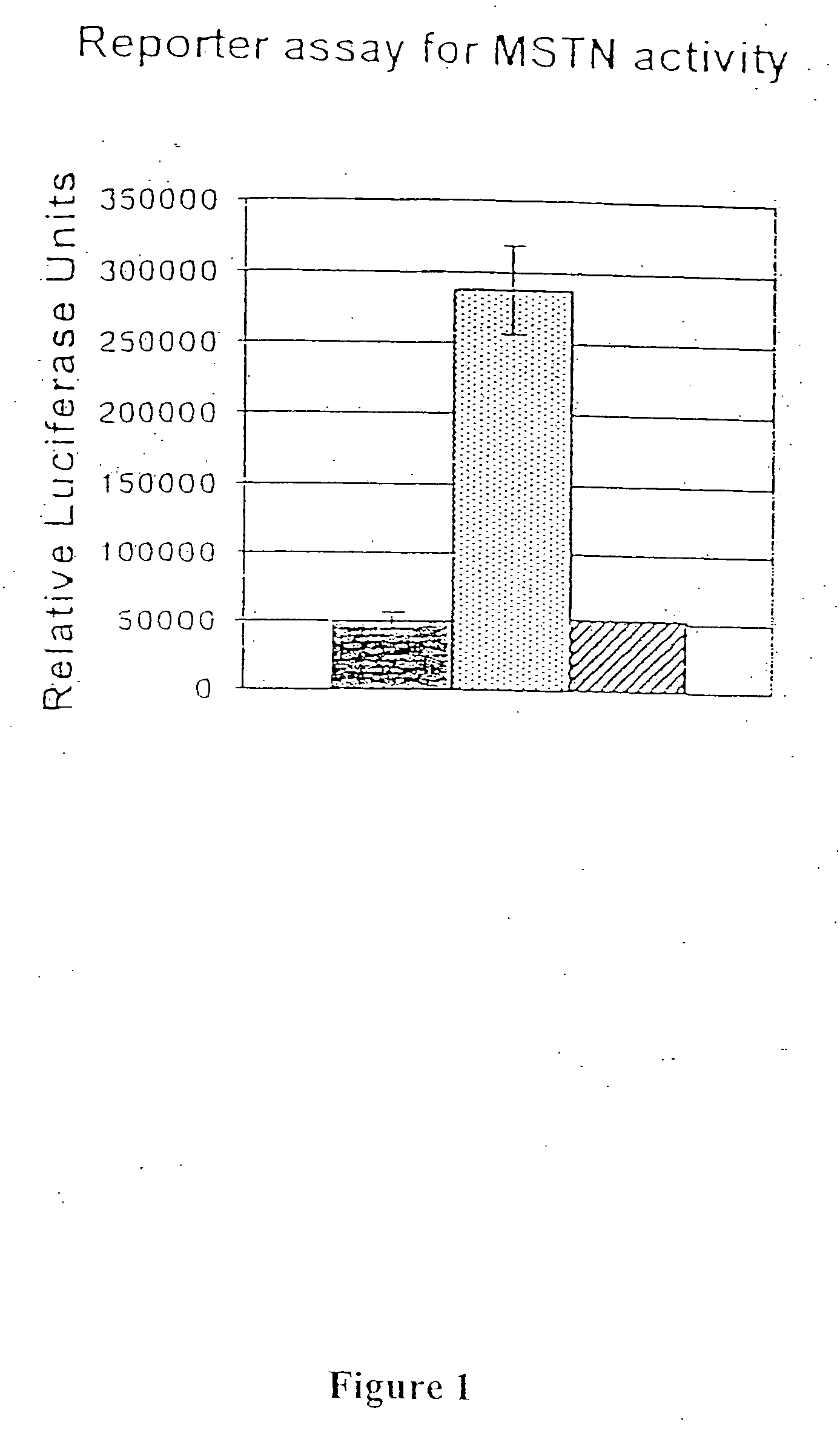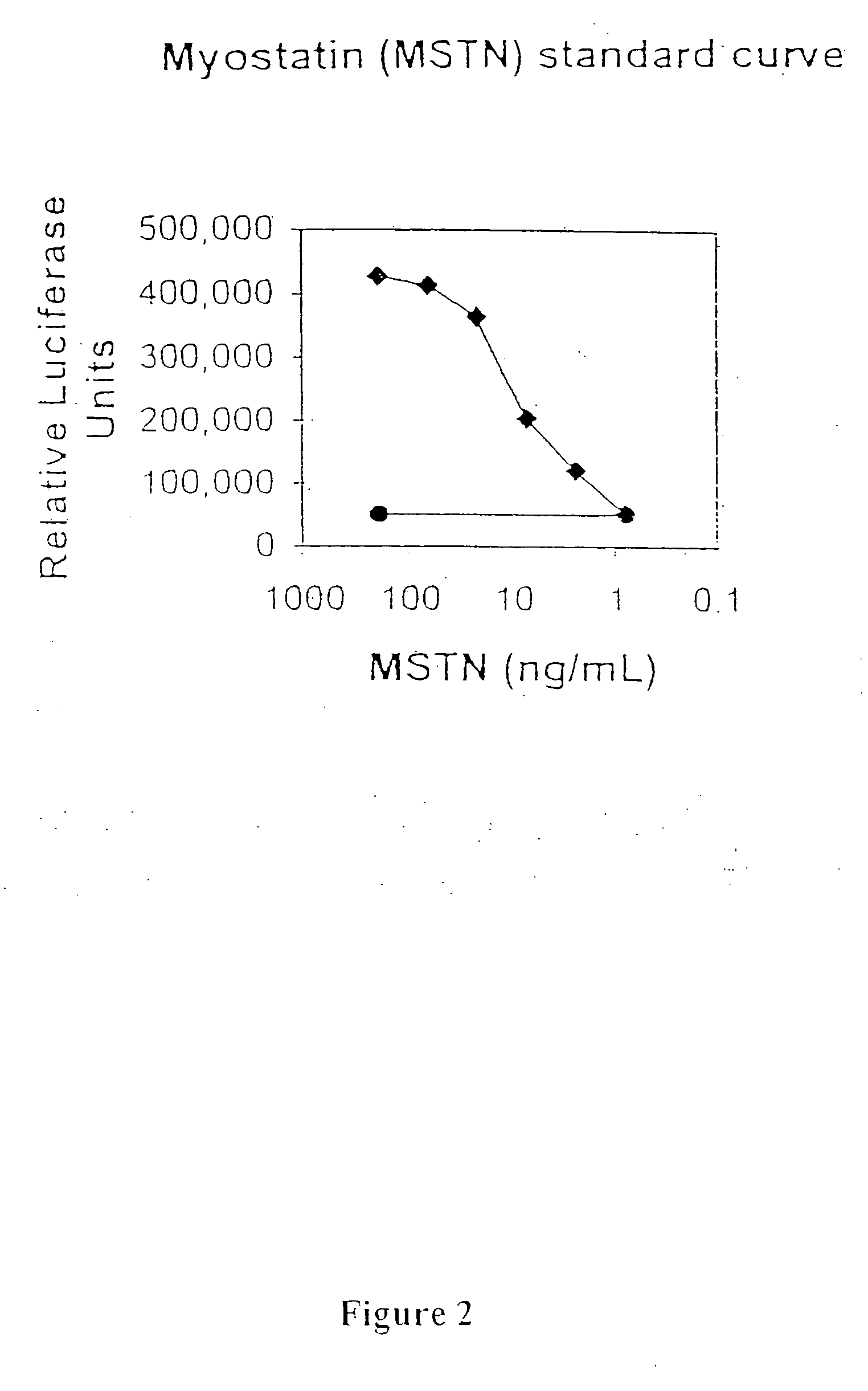Metalloprotease activation of myostatin, and methods of modulating myostatin activity
a myostatin and metalloprotease technology, applied in the field of can solve the problems of diverse and deleterious effects, and achieve the effects of facilitating the action or activity of the agent, reducing or inhibiting metalloprotease mediated activation of latent myostatin, and increasing or decreasing cleavage activity
- Summary
- Abstract
- Description
- Claims
- Application Information
AI Technical Summary
Benefits of technology
Problems solved by technology
Method used
Image
Examples
example 1
BMP-1 / TLD Metalloprotease Family Members Cleave Myostatin Pro Peptide
[0090] This example demonstrates that the members of the bone morphogenic protein-1 / Tolloid (BMP-1 / TLD) family of metalloproteases cleave the myostatin pro peptide.
[0091] Five hundred ng of purified myostatin pro peptide or of purified latent myostatin complex comprising the pro peptide and C-terminal dimer (Lee and McPherron, supra, 2001) was incubated overnight at 37° C. with 100 ng purified BMP-1, mTLD, mTLL-1, or mTLL-2 (Scott et al., Devel. Biol. 213:283-300, 1999, which is incorporated herein by reference). Reaction products were analyzed by sodium dodecyl sulfate-polyacrylamide gel electrophoresis (SDS-PAGE) followed by western blot analysis using antiserum raised against the myostatin pro peptide (Lee and McPherron, supra, 2001).
[0092] A discrete proteolytic cleavage product of the pro peptide was detected in each reaction containing one of the four proteases, but not in control reactions that did not co...
example 2
Metalloprotease Cleavage of Myostatin Pro Peptide Activates Latent Myostatin
[0093] This example demonstrates that cleavage of the myostatin pro peptide by a BMP-1 / TLD metalloprotease activates latent myostatin.
[0094] Purified myostatin pro peptide and C-terminal dimer complex was incubated with mTLL-1, then examined using a reporter gene assay that specifically detects myostatin activity. A204 rhabdomyosarcoma cells were transfected with the pGL3-(CAGA)12 luciferase reporter gene construct, which comprises the luciferase coding sequence linked to the TGF-Θ responsive CAGA sequence from the promoter of the TGF-Θ inducible PAI-1 gene (Thies et al., supra, 2001). The transfected cells were contacted with either untreated pro peptide / C-terminal dimer complex or complex that had been pre-incubated with mTLL-1. Incubation of the complex with mTLL-1 dramatically increased the amount of luciferase activity detected in the reporter cell assay, whereas no change was observed in cells treate...
example 3
Peptide Substrates for Tolloid Family Members
[0096] A series of three peptides each of 10, 20, 30, 40, or 50 amino acid residues was synthesized based on the sequence of the myostatin pro peptide, and encompassing the BMP-1 / TLD metalloprotease cleavage site (amino acid residues “RD” as shown in bold, below, in wild type peptides; SEQ ID NOS:9, 12, 15, 18, and 21). Peptides in which the arginine residue at the P1 position just upstream of the cleavage site was changed to a glutamine residue (SEQ ID NOS: 10, 13, 16, 19, and 22; see bold), and peptides in which the aspartic acid at the P1′ position just downstream of the cleavage site was changed to an alanine (SEQ ID NOS: 11, 14, 17, 20, and 23; see bold), also were synthesized. The sequences of the peptides are shown below:
[0097] 50-mer
KDVIRQLLPKAPPLRELIDQYDVQRDDSSDGSLEDD(SEQ ID NO:9)DYHATTETIITMPTKDVIRQLLPKAPPLRELIDQYDVQQDDSSDGSLEDD(SEQ ID NO:10)DYHATTETIITMPTKDVIRQLLPKAPPLRELIDQYDVQRADSSDGSLEDD(SEQ ID NO:11)DYHATTETIITMPT
[0098]...
PUM
| Property | Measurement | Unit |
|---|---|---|
| concentrations | aaaaa | aaaaa |
| dissociation constant | aaaaa | aaaaa |
| dissociation constant | aaaaa | aaaaa |
Abstract
Description
Claims
Application Information
 Login to View More
Login to View More - R&D
- Intellectual Property
- Life Sciences
- Materials
- Tech Scout
- Unparalleled Data Quality
- Higher Quality Content
- 60% Fewer Hallucinations
Browse by: Latest US Patents, China's latest patents, Technical Efficacy Thesaurus, Application Domain, Technology Topic, Popular Technical Reports.
© 2025 PatSnap. All rights reserved.Legal|Privacy policy|Modern Slavery Act Transparency Statement|Sitemap|About US| Contact US: help@patsnap.com



